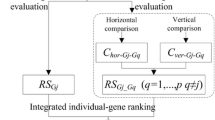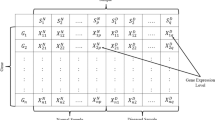Abstract
In the proposed method, Laplacian criteria is firstly introduced to sort the genes as their descending scores. And then, correlation analysis is applied to select those pathogenic genes from the sorted sequence to reduce the redundancy. At last, SVM classifier is used to predict the class labels of the optimal gene subset. Compared to some other related gene selection methods such as Fisher score and Laplacian score, Experimental results on four standard datasets have shown the stability and efficiency of the proposed method.
Access this chapter
Tax calculation will be finalised at checkout
Purchases are for personal use only
Similar content being viewed by others
References
Martinez, A.M., Kak, A.C.: PCA versus LDA. IEEE Trans. Pattern Anal. Mach. Intell. 23(2), 228–233 (2001)
Jolliffe, I.T.: Principal Component Analysis. Springer, Heidelberg (2002)
Fort, G., Lacroix, S.L.: Classification using partial least squares with penalized logistic regression. Bioinformatics 21(7), 1104–1111 (2005)
Huang, D.S., Zheng, C.H.: Independent component analysis based penalized discriminate method for tumor classification using gene expression data. Bioinformatics 22, 1855–1862 (2006)
Pochet, N., Smet, F.D., Suykens, J.A., Moor, B.D.: Systematic benchmarking of microarray data classification: assessing the role of non-linearity and dimensionality reduction. Bioinformatics 20(3), 3185–3195 (2004)
Alexandridis, R., Lin, S., Irwin, M.: Class discovery and classification of tumor samples using mixture modeling of gene expression data—a unified approach. Bioinformatics 20(16), 2545–2552 (2004)
Martella, F.: Classification of microarray data with factor mixture models. Bioinformatics 22(3), 202–208 (2006)
Pillati, M., Viroli, C.: Supervised locally linear embedding for classification: an application to gene expression data analysis. In: 29th Annual Conference of the German Classification Society (GfKl 2005), pp. 15–18 (2005)
Li, B., Tian, B.B., Zhang, X.L., Zhang, X.P.: Locally linear representation Fisher criterion based tumor gene expressive data classification. Comput. Biol. Med. 44(10), 48–54 (2014)
Cui, Y., Zheng, C.H., Yang, J., Sha, W.: Sparse maximum margin discriminant analysis for feature extraction and gene delection on gene expressive data. Comput. Biol. Med. 43, 933–941 (2013)
Juan, M.G.G., Juan, G.S., Pablo, E.M., Elies, F.G., Emilio, S.O.: Sparse manifold clustering and embedding to discriminant gene expression profiles of glioblastoma and meningioma tumors. Comput. Biol. Med. 43, 1863–1869 (2013)
Mundra, P.A., Rajapakse, J.C.: SVM-RFE with MRMR filterfor gene selection. IEEE Trans. Nanobiosci. 9(1), 31–37 (2010)
He, X., Cai, D., Niyogi, P.: Laplacian score for feature selection. In: Advances in Neural Information Processing Systems, pp. 507–514 (2005)
Zhao, Z., Wang, L., Liu, H., Ye, J.: On similarity preserving feature selection. IEEE Trans. Knowl. Data Eng. 25(3), 619–632 (2011)
Nie, F., Huang, H., Cai, X., Ding, C.H.: Efficient and robust feature selection via joint l2, 1-norms minimization. In: Advances in Neural Information Processing Systems, pp. 1813–1821 (2010)
Acknowledgement
This work was partly supported by the grants of Natural Science Foundation of China (61273303, 61273225, 61373109 and 61572381), China Postdoctoral Science Foundation (20100470613 and 201104173), Natural Science Foundation of Hubei Province (2010CDB03302), the Research Foundation of Education Bureau of Hubei Province (Q20121115).
Author information
Authors and Affiliations
Corresponding author
Editor information
Editors and Affiliations
Rights and permissions
Copyright information
© 2016 Springer International Publishing Switzerland
About this paper
Cite this paper
Li, B., Lei, XH., Hu, Y., Zhang, XL. (2016). A Hybrid Tumor Gene Selection Method with Laplacian Score and Correlation Analysis. In: Huang, DS., Bevilacqua, V., Premaratne, P. (eds) Intelligent Computing Theories and Application. ICIC 2016. Lecture Notes in Computer Science(), vol 9771. Springer, Cham. https://doi.org/10.1007/978-3-319-42291-6_21
Download citation
DOI: https://doi.org/10.1007/978-3-319-42291-6_21
Published:
Publisher Name: Springer, Cham
Print ISBN: 978-3-319-42290-9
Online ISBN: 978-3-319-42291-6
eBook Packages: Computer ScienceComputer Science (R0)




